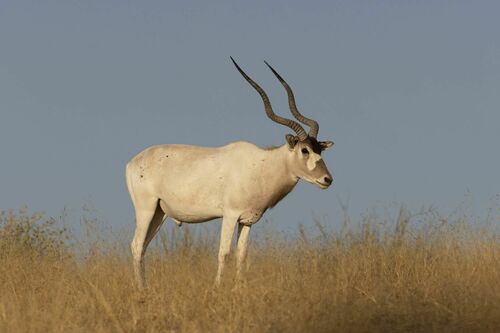
Addax
The Addax, an antelope of the Sahara, is masterfully adapted to desert life. Its spiraled horns and seasonal coat make it a striking presence amidst the dunes. Critically endangered, the Addax is a symbol of resilience, relying on scarce desert vegetation and minimal water to survive.
19-25 years
Lifespan
Length: 1.19 - 1.3 m; Height: 1.0414 - 1.143 m
Size
White, Grey-Brown
Color
2 years
Age of Sexual Maturity
5-9 months
Age of Weaning
Critically Endangered
Conservation Status
Decreasing
Population Trend
Characteristics
The Addax, or Addax nasomaculatus, is a critically endangered antelope found in the Sahara Desert. It is well-adapted to arid environments, with spiral horns, a sandy coat that changes with the seasons, and a diet primarily consisting of desert grasses and herbs.
Distribution Range of the Addax
The Addax (Addax nasomaculatus) is native to the Sahara Desert region of northern Africa. Historically, its geographical distribution included countries such as Mauritania, Chad, Niger, Libya, and Sudan. However, due to habitat loss and hunting, their range has drastically reduced and they are now found primarily in remote areas of the Sahel region, particularly within Niger's Termit Massif and Tin-Toumma desert.
Addax's Habitat
Environmental Conditions
The Addax inhabits harsh desert and semi-desert environments characterized by extreme temperatures, scarce water sources, and minimal vegetation. These areas typically have sandy or stony substrates and sparse vegetation consisting mainly of grasses, shrubs, and acacia trees, which are crucial for their diet.
Ecological Niche
As a desert-adapted ungulate, the Addax has evolved several adaptations to survive in its arid environment. It is primarily nocturnal to avoid daytime heat, and it can go long periods without water, deriving moisture from the plants it consumes. The Addax plays a role in its ecosystem by grazing on vegetation, which helps maintain the desert plant community balance.
Copyright @ Nature Style Limited. All Rights Reserved.
 English
English